一、判断题:











二、选择题:
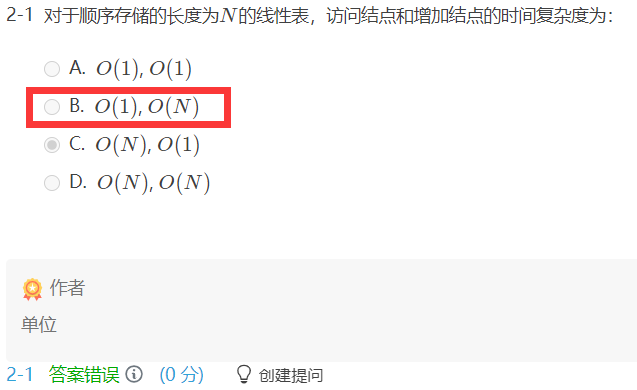



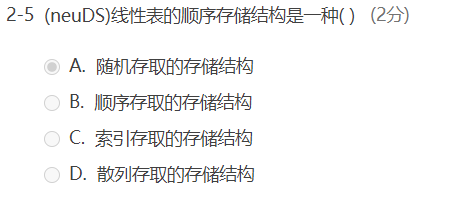
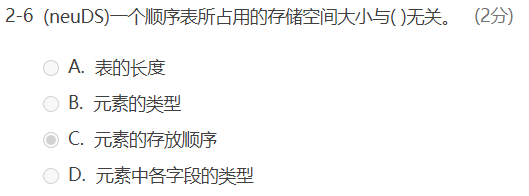

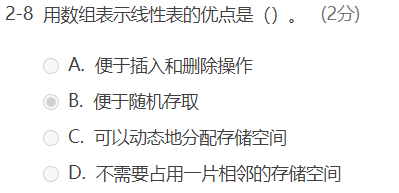





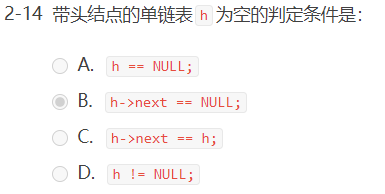

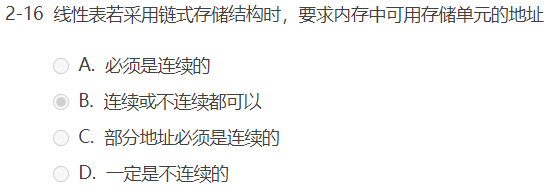


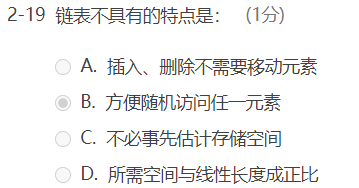


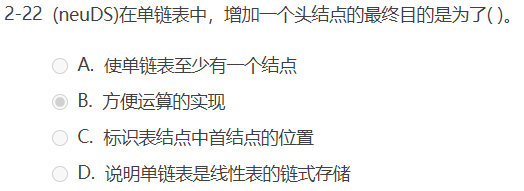
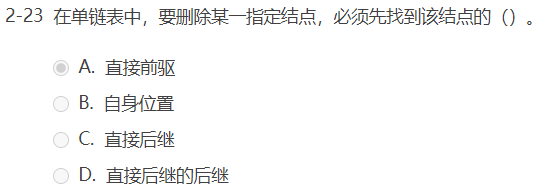



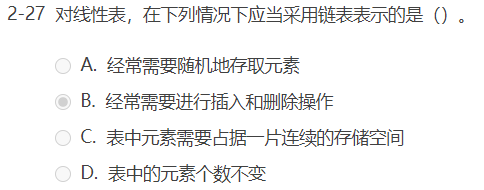



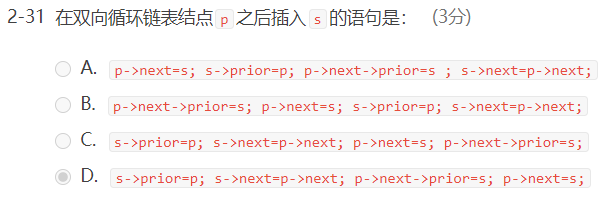
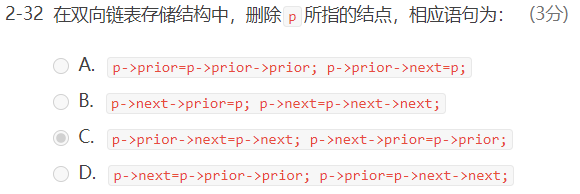




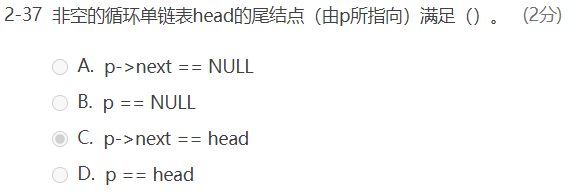








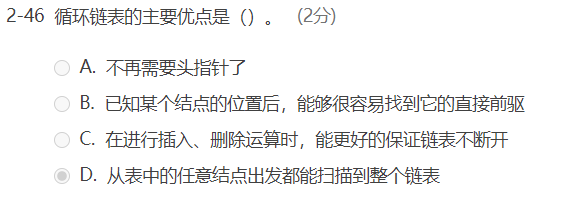
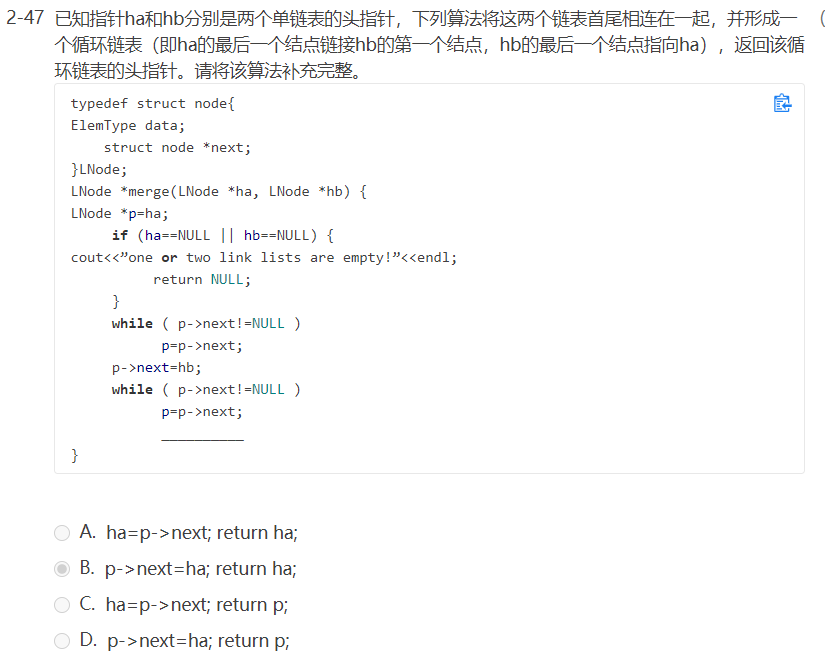
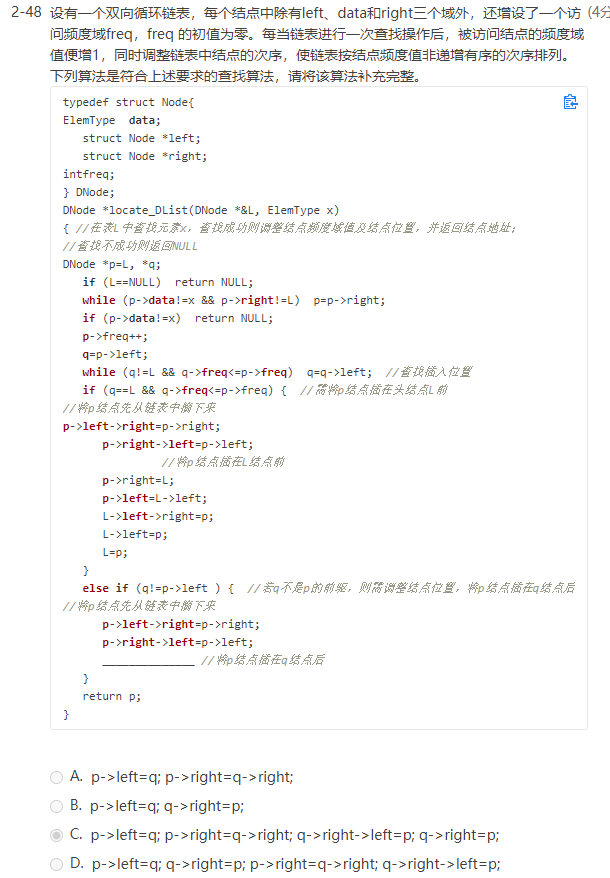
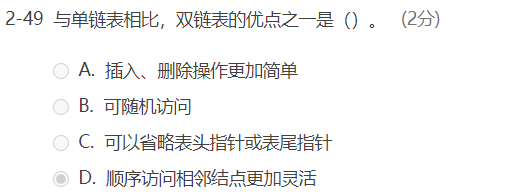

三、编程题:
7-1 jmu-ds-顺序表区间元素删除 :

输入样例:
10
5 1 9 10 67 12 8 33 6 2
3 10
输出样例:
1 67 12 33 2
代码:

#include<stdio.h>
int main()
{
int a[10001];
int b[10001];//开辟两个比较大的数组
int n;
scanf("%d",&n);
int i;
for(i=0;i<n;i++)
scanf("%d",&a[i]);//将数读入
int x, y;
int j=0;
scanf("%d %d",&x,&y);
for(i=0;i<n;i++)//利用区间判断大小,将区间以外的数加入新数组
{
if(a[i]<x||a[i]>y)
{
b[j]=a[i];
j++;
}
}
printf("%d",b[0]);
for(i=1;i<j;i++)
{
printf(" %d",b[i]);
}
}
7-2 两个有序链表序列的合并:

输入样例:
1 3 5 -1
2 4 6 8 10 -1
输出样例:
1 2 3 4 5 6 8 10
代码:

#include<stdio.h>
#include<stdlib.h>
typedef struct LNode//链表
{
int data;
struct LNode *next;
}LNode, *LinkList;
void MergeList_L(LinkList La, LinkList Lb, LinkList Lc)//排序
{
La=La->next;
Lb=Lb->next;
while(La!=NULL&&Lb!=NULL)
{
if(La->data > Lb->data)
{
Lc->next=Lb;
Lb=Lb->next;
}
else
{
Lc->next=La;
La=La->next;
}
Lc=Lc->next;
}
if(La==NULL&&Lb==NULL) return;
if(La!=NULL)
Lc->next=La;
else
Lc->next=Lb;
return;
}
LinkList InitList()//
{
LinkList l;
l=(LinkList) malloc (sizeof(struct LNode));
if(!l) return NULL;
l->next=NULL;
return l;
}
void ReadList_L(LinkList LLL)//读取
{
LinkList temp;
int data;
scanf("%d",&data);
while(data>0)
{
temp=(LinkList)malloc(sizeof(struct LNode));
if(!temp)return;
temp->data=data;
temp->next=NULL;
LLL->next=temp;
LLL=temp;
scanf("%d",&data);
}
return;
}
void PrintList_L(LinkList LL)//打印
{
LL=LL->next;
if(LL==NULL)
{
printf("NULL");
return;
}
while(LL)
{
if(LL->next==NULL)
printf("%d",LL->data);
else printf("%d ",LL->data);
LL=LL->next;
}
}
int main()
{
LinkList s1,s2,S;
s1 = InitList();
s2 = InitList();
S = InitList();
ReadList_L(s1);
ReadList_L(s2);
MergeList_L(s1, s2, S);
PrintList_L(S);
return 0;
}
7-3 两个有序链表序列的交集:

输入样例:
1 2 5 -1
2 4 5 8 10 -1
输出样例:
2 5
代码:

#include<stdio.h>
int a[10000001],b[100000001];
int L1=0,L2=0;
#define true 1
int main()
{
int i=0,j=0,index=-1;
while(true)//依次读入数组
{
int aa;
scanf("%d",&aa);
if(aa==-1)
break;
else
a[L1]=aa,L1++;
}
while(true)//依次读入数组
{
int bb;
scanf("%d",&bb);
if(bb==-1)
break;
else
b[L2]=bb,L2++;
}
while(i<L1 && j<L2)
{
if(a[i]==b[j])//出现交集,按规定格式输出
{
if(index==-1)
{
printf("%d",a[i]);
}
else
{
printf(" %d",a[i]);
}
i++,j++,index++;
}
else if(a[i] > b[j])//第一个数组对应的数值大于第二个,让第二个数组的下一个进行比较
j++;
else
i++;
}
if(index==-1)
printf("NULL
");
else
printf("
");
return 0;
}
7-4 一元多项式的乘法与加法运算:
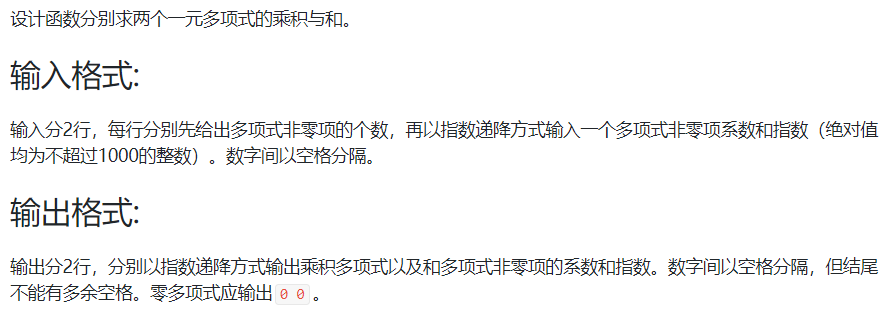
输入样例:
4 3 4 -5 2 6 1 -2 0
3 5 20 -7 4 3 1
输出样例:
15 24 -25 22 30 21 -10 20 -21 8 35 6 -33 5 14 4 -15 3 18 2 -6 1
5 20 -4 4 -5 2 9 1 -2 0
代码:

#include<iostream>
#include<cstring>
using namespace std;
int t1[1005],t2[1005],s1[2005],s2[2005];//定义全局数组
int main(){
int n1,n2,a,b;
memset(t1,0,sizeof(t1));
memset(t2,0,sizeof(t2));
memset(s1,0,sizeof(s1));
memset(s2,0,sizeof(s2));//初始化数组
cin>>n1;//先输入系数,后输入指数
for(int i=0;i<n1;i++){
cin>>a>>b;
t1[b]=a;
}
cin>>n2;
for(int i=0;i<n2;i++){
cin>>a>>b;
t2[b]=a;
}////指数作为下标,系数作为数组元素
for(int i=0;i<=1000;i++){
for(int j=0;j<=1000;j++){
s1[i+j]+=t1[i]*t2[j];
}
}
for(int o=0;o<=1000;o++){
s2[o]+=t1[o]+t2[o];
}
int tag=0;
for(int i=2000;i>=0;i--)
if(s1[i]!=0){
if(tag)
cout<<" ";
tag=1;
cout<<s1[i]<<" "<<i;
}//判断个事进行输出
if(!tag)cout<<"0 0";
cout<<endl;
tag=0;
for(int i=1000;i>=0;i--)
if(s2[i]!=0){
if(tag)
cout<<" ";
tag=1;
cout<<s2[i]<<" "<<i;
}//同上
if(!tag)cout<<"0 0";
cout<<endl;
return 0;
}
7-5 一元多项式求导:

输入样例:
3 4 -5 2 6 1 -2 0
输出样例:
12 3 -10 1 6 0
代码:

#include<bits/stdc++.h>
using namespace std;
int main()
{
int a, b;
int s = 0;//用于计算系数和幂的乘积
cin>>a>>b;
if(b != 0)
cout<<(a*b)<<" "<<(b-1);//先计算一组,方便最后一组末尾的消除空格
else//特殊情况:即多项式为常数的情况
{
cout<<"0 0";
return 0;
}
while(scanf("%d %d", &a, &b) != EOF)//输入多组数据
{
if(b != 0)
{
s = a*b;
cout<<" "<<s<<" "<<(b-1);//进行求导计算
}
}
return 0;
}
7-6 求链式线性表的倒数第K项 :

输入样例:
4 1 2 3 4 5 6 7 8 9 0 -1
输出样例:
7
代码:

#include<stdio.h>
int a[1000001];//第一次提交显示数组越界(段错误)
int main()
{
int look_for;
scanf("%d",&look_for);//读入下标
int index;
int i = 0;
while(scanf("%d",&index)>=0)//将大于等于0的数读入
{
a[i]=index;
i++;
}
i--;//循环里面多一次i++,减掉
if(i-look_for<0)//判断下标是否符合要求
{
printf("NULL
");
}
else
{
printf("%d
",a[i-look_for]);
}
return 0;
}
